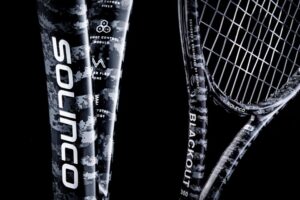
Weather-Ready Tennis: How to Prepare for Colder Court Conditions
—
Playing tennis in cold weather comes with a unique set of challenges. Whether you’re a seasoned player or a novice enthusiast, adapting to the changing climate is essential to maintain your edge during winter matches.
From equipment adjustments to fitness considerations, Coach Michael Russell, current coach to Taylor Fritz and Solinco ambassador, gives us his insights on ways to prepare and excel in colder court conditions.
WHAT IS THE IMPACT OF COLD WEATHER ON TENNIS PERFORMANCE?
Mike Russell: Cold weather has a major impact on tennis performance. It slows the conditions down drastically. The tennis ball doesn’t travel through the air as fast and typically the impact of the ball on the strings feels less lively.
In the winter months, players must also be prepared for windy conditions and rain delays, both of which can present challenges to mental focus and physical stamina.
The key to success in colder weather is preparing with a solid warm-up well before the match begins.
HOW SHOULD I WARM-UP BEFORE A MATCH IN COLD WEATHER?
Mike Russell: Increasing the time for the dynamic warm up is important to ensure that the player has a light sweat when stepping on court. It’s also important that you dress appropriately for the weather conditions which includes cold gear leggings or under shirts that help insulate and regulate the player’s core temperature.
HOW SHOULD I ADJUST MY EQUIPMENT FOR COOLER WEATHER?
Mike Russell: Every player is different with their preferred equipment setup, however I usually recommend dropping the string tension by a few pounds. This will give you more grab and feel at impact. Looser tension also helps with power generation, especially in the colder, slower conditions.
SOLINCO OFFERS A WIDE VARIETY OF STRING GAUGES AND SPECIFICATIONS TO SUIT PLAYER’S UNIQUE PERFORMANCE NEEDS. EXPLORE SOLINCO’S LINEUP OF HIGH-PERFORMANCE STRINGS.

WHAT TACTICS WORK WELL FOR PLAYING IN WINDY CONDITIONS?
Mike Russell : Playing in the wind can be tricky. You’ll need to constantly adjust your optimal targets, contact zones and margins over the net based on which way the wind is moving. It’s difficult to be precise in the wind.
Focusing on your footwork, giving yourself bigger targets, and not hitting so close to the lines helps. If the wind is at your back, you’ll need to play with more topspin to keep the ball in. If the wind is in your face, then you need to drive through the ball with higher margins over the net. You can also mix in slices and drop shots, since the wind will help aid these shots.
Serving and volleying can be a good play against the wind because it’s difficult for the opponent to get the return at the servers feet.
Adjustments in footwork, shot selection, and game strategy can help you maintain control and exploit opportunities on the court.
HOW CAN PLAYERS MANAGE RAIN DELAYS EFFECTIVELY?
Mike Russell : Rain delays unfortunately are a part of tennis. Your success depends on how well you maximize your time management skills during the delay.
Some of the best practices include:
1. Changing into new tennis gear, especially shoes, ensures comfort and assists in maintaining traction on the court.
2. Eating a small meal or snack to help replenish your energy levels.
3. Hydrate. Hydrate. Hydrate!
4. Strategize with your coach or mentor. This is a great time to review your game plan, analyze your opponents’ strategies, and make any necessary adjustments.
4. Lastly, re-warming up properly is crucial. Engaging in a series of warm-up exercises helps to reactivate muscles, enhance flexibility and reduce the risk of injury before the match resumes.
WHAT IS THE BEST WAY TO COOL DOWN AND STRETCH AFTER MY MATCH?
Just like playing in hot weather conditions, the cool down is an essential component of tennis recovery.
Use the cooldown to eliminate lactic acid built up from the match. This is also an optimal time to work on your flexibility and mobility while the body is still warm. If there is a covered, warmer area that has a bike or treadmill for the cool down process that is ideal. Use the equipment for an easy spin or light jog for 10 minutes, followed by a series of full body static and dynamic stretches.
THE BOTTOM LINE
In the world of tennis, playing through cold weather poses yet another hurdle for players to conquer. Embracing this challenge is not only a test of skill but provides an opportunity to showcase your adaptability and resilience on the court.
To excel in adverse weather conditions, a fusion of preparation, flexibility, and strategic adjustments to equipment and gameplay is essential. By understanding the nuances of colder climates and applying new, recommended tactics, players can turn potential obstacles into opportunities.

SHARE
Explore Solinco
Back by Demand: More from the Solinco x Brain Dead Collection
Back by popular demand, the Solinco x Brain Dead Acid Chrome tennis collection returns. The lineup includes the limited edition Whiteout V2, the Hyper-Mach BD hybrid string set, and a brand-new single racquet bag in the signature AcidChrome style. Built for performance
Read MoreDiscover the New Whiteout V2 18×20 & 18×20 XTD: Precision, Spin, and Power in One Racquet
Introducing the new Solinco Whiteout V2 18×20 and 18×20 XTD— Perfect for aggressive players seeking a lower launch angle and all-court versatility.
Read MoreSolinco Blackout 300 V2 Review Roundup: Power, Comfort, and Control Perfected
Discover why players and reviewers are raving about the Solinco Blackout 300 V2. Combining explosive power, comfort, and stability, this modern performance racquet stands out as a true all-court weapon.
Read More





























